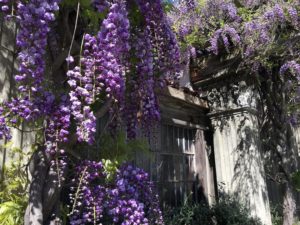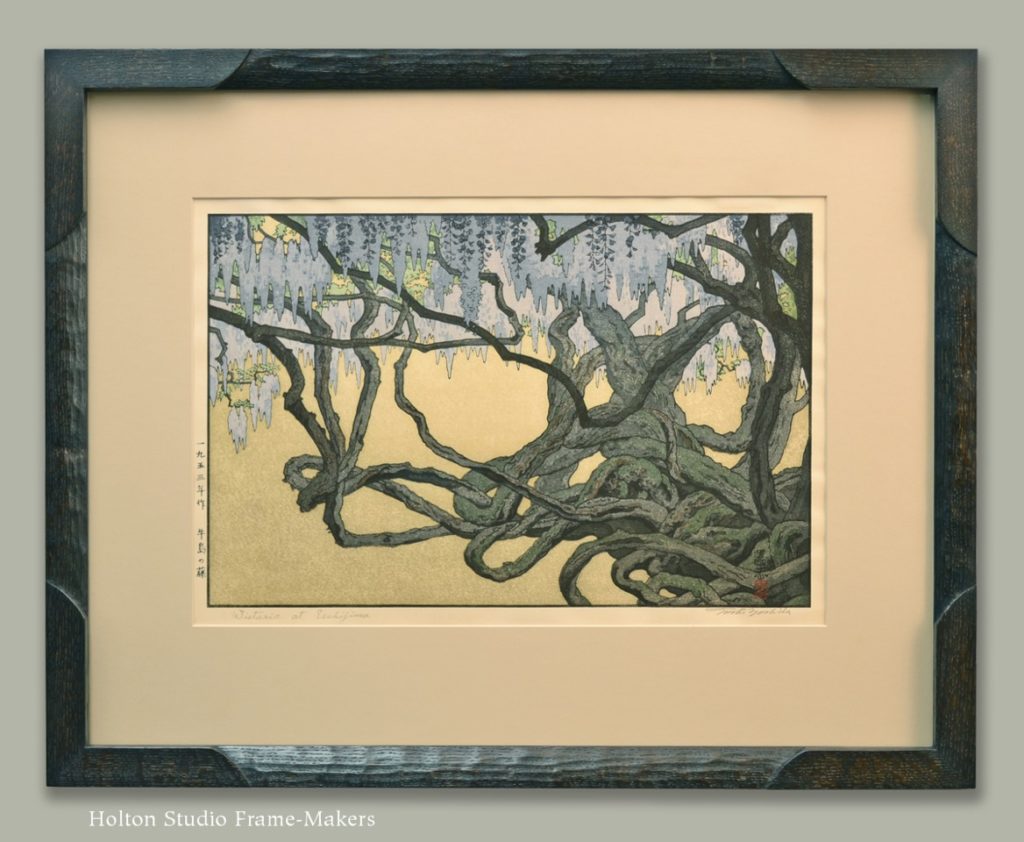I love wisteria, and right now, at the peak of spring here in Berkeley, wisteria are everywhere and in full flower.

Wisteria on Berkeley brown shingle home. Photo: Colleen Neff, Berkeleyside
Folks grow them over their doors and windows, and so they are nature’s ornament framing everyday comings and goings—very suitable to Berkeley’s tradition of building with nature which made it a center for Arts and Crafts ideals and exemplary Craftsman homes.

“Wisteria Pergola,” by Yoshiko Yamamoto
Yoshiko Yamamoto’s block print, “Wisteria Pergola,” inspired by Greene and Greene’s Irwin Duncan house in another Arts and Crafts town, Pasadena, is one we’ve enjoyed framing (and currently have in the Gallery).
I especially love wisteria’s gnarly old vines, like those that grow on Bernard Maybeck’s masterpiece, the First Church of Christ, Scientist (below). The juxtaposition of the new flowers and old vines captures the whole spirit of spring—not just new life, but the renewal of life. It’s the spirit Maybeck built in, freely making the ancient building traditions his own to create something completely fresh and vital.

Wisteria on Maybeck’s First Church of Christ, Scientist. Photo: Colleen Neff, Berkeleyside
So it’s an appropriate season to post this lovely 1953 woodblock which we framed recently, “Wisteria at Ushijima”, by the great Japanese printmaker, Toshi Yoshida (1911-1995). The frame is hand carved quartersawn white oak (Saturated Medieval Oak stain). And in the spirit of the newness of spring—and treating frame-making as a vital art form—this is a new frame design. We’ve been playing with carved shapes on narrow frames and flat corners (another example is the cap molding on Paul Kratter’s “Point Lobos Cypress”), and in this case the wonderfully rendered old vines called out for the cushion form with its carved texture. The flat, uncarved corners play the foil to the convex carved portions. The heavier, articulated corners also provide a sense of protection for the print—the first and most important duty of the frame and a sound basis for pleasing design.
Another reason this is a suitable springtime piece to share is that Toshi Yoshida and especially his father, Hiroshi (for whom our Yoshida frame is named), gave renewed life to the venerable Japanese tradition of block printing—as Yoshiko continues to do. If you haven’t explored the Yoshidas and their whole tradition of shin-hanga and sosaku-hanga, I highly recommend doing so. You might start with hanga.com, a wonderful site.

Toshi Yoshida, “Wisteria at Ushijima,” 1953. Woodblock, 14 5/8″ x 9 1/2″. Framed in No. 400 CV Flat Corners—1″ in quartersawn white oak (Saturated Medieval Oak stain).
 Update (4/30): The First Church of Christ, Scientist just posted this on Facebook — “April is “wisteria month” at First Church! The flowering vines are in full bloom and many visitors on five scheduled tours last week snapped pictures of them. The one shown below was taken by tour guide Judy Porta. The wisteria were part of architect Bernard Maybeck’s plan for the landscaping and they are definitely a “character defining” feature of the the City of Berkeley’s National Historic Landmark, First Church of Christ, Scientist, and very much admired, resting on their Arts and Crafts pergolas. Come join us for the regularly scheduled tour on the first Sunday of the Month (May 7) at 12:15 and enjoy the Wisteria while they remain in bloom. 2892 Dwight Way at Bowditch St.” View on Facebook…
Update (4/30): The First Church of Christ, Scientist just posted this on Facebook — “April is “wisteria month” at First Church! The flowering vines are in full bloom and many visitors on five scheduled tours last week snapped pictures of them. The one shown below was taken by tour guide Judy Porta. The wisteria were part of architect Bernard Maybeck’s plan for the landscaping and they are definitely a “character defining” feature of the the City of Berkeley’s National Historic Landmark, First Church of Christ, Scientist, and very much admired, resting on their Arts and Crafts pergolas. Come join us for the regularly scheduled tour on the first Sunday of the Month (May 7) at 12:15 and enjoy the Wisteria while they remain in bloom. 2892 Dwight Way at Bowditch St.” View on Facebook…